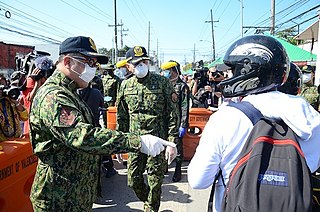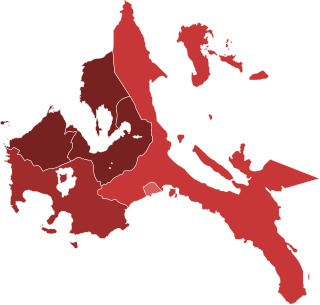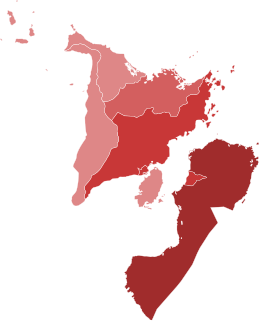
Francisco Tiongson Duque III is a Filipino physician and government official currently serving as the Secretary of Health since 2017 in the Cabinet of President Rodrigo Duterte. He also previously served as Secretary of Health from 2005 to 2010 under the administration of President Gloria Macapagal Arroyo. From 2010 to 2015, he served as the Chairman of the Civil Service Commission.
2020 in the Philippines details events of note that have occurred, or are scheduled to take place, in the Philippines in the year 2020.

The ongoing pandemic of coronavirus disease 2019, a novel infectious disease caused by severe acute respiratory syndrome coronavirus 2, spread to the Philippines on January 30, 2020, when the first case of the disease was confirmed in Metro Manila. It involved a 38-year-old Chinese woman who was confined in the San Lazaro Hospital in Manila. The second case was confirmed on February 2, that of a 44-year-old Chinese man who died a day earlier, which was also the first confirmed death from the disease outside mainland China. The first case of someone without travel history abroad was confirmed on March 5, a 62-year-old male who frequented a Muslim prayer hall in San Juan, Metro Manila, raising suspicions that a community transmission of COVID-19 is already underway in the Philippines. The man's wife was confirmed to have contracted COVID-19 on March 7, which was also the first local transmission to be confirmed.

The first confirmed case of the pandemic of coronavirus disease 2019 (COVID-19) in the United Arab Emirates was announced on 29 January 2020. It was the first country in the Middle East to report a confirmed case. The first patient, a 73-year-old Chinese woman, was released on 9 February after recovering. The first two deaths were confirmed on March 20. On 22 March, Dubai started an 11-day sterilisation campaign as an effort to contain the coronavirus. Night curfew was imposed 4 days later while the country began disinfection. School closure was first announced on March 8 for 4 weeks. 3 weeks later, it was announced that school will be closed until the end of the academic year.

This article documents the chronology and epidemiology of SARS-CoV-2 in April 2020, the virus responsible for the 2019–20 coronavirus pandemic which originated in Wuhan, Hubei, mainland China. Some developments may become known or fully understood only in retrospect.
The first case of the COVID-19 disease caused by the SARS-CoV-2 virus in Qatar was confirmed on 27 February 2020. As of May 2, Qatar has the 2nd highest number of confirmed cases in the Arab World at 14,872. The total recoveries stand at 1,534, with 12 deaths.

The 2019–20 coronavirus pandemic was confirmed to have reached Ivory Coast in March 2020.

The 2019–20 coronavirus pandemic was confirmed to have spread to Metro Manila, Philippines on January 30, 2020, when the first case of coronavirus disease 2019 (COVID-19) was confirmed in the City of Manila. After a month of no new cases in the country, the first case of someone without travel history abroad was confirmed on March 5, a 62-year-old male who frequented a Muslim prayer hall in San Juan, Metro Manila, raising suspicions that a community transmission of COVID-19 is already underway in the Philippines. The man's wife was confirmed to have contracted COVID-19 on March 7, which was also the first local transmission to be confirmed. Metro Manila is the worst affected region in the Philippines, where most cases are recorded. A state of calamity and community quarantine have been in place in the region since March 15.
The 2019–20 coronavirus pandemic was confirmed to have reached Tanzania in March 2020.

On March 16, 2020, Philippine President Rodrigo Duterte declared the entire Luzon area in the Philippines under "enhanced community quarantine" (ECQ) which is effectively a total lockdown, restricting the movement of the population but with exceptions, in response to the growing pandemic of coronavirus disease 2019 (COVID-19) in the country. Additional lockdown restrictions mandated the temporary closure of non-essential shops and businesses. This quarantine came two days after the implementation of the community quarantine of Metro Manila.
The coronavirus testing controversy is an ongoing controversy involving several government officials who were reported in media to have been tested for coronavirus disease 2019 (COVID-19) in the first months of the coronavirus pandemic in the Philippines. This violated the triage algorithm used by the Department of Health (DOH), which said that asymptomatic patients should not be tested, and should instead be put under 14-day house quarantine.

The Bayanihan to Heal as One Act, officially designated as Republic Act No. 11469, is a law in the Philippines that was enacted in March 2020 granting the President additional authority to combat the 2020 coronavirus pandemic in the Philippines. The word "bayanihan" is a Tagalog word for communal work.

As a measure to limit the spread of coronavirus disease 2019 (COVID-19) in the Philippines, lockdowns, officially characterized as "community quarantines" by the government, of varying strictness was imposed in numerous parts of the Philippines. The enhanced community quarantine, is the strictest of such measures. The largest of these measures was the Luzon enhanced community quarantine.

The 2019–20 coronavirus pandemic was confirmed to have spread to the Davao Region, Philippines on March 15, 2020, when the first case of coronavirus disease 2019 (COVID-19) was confirmed in Tagum. All provinces, except Davao Occidental has at least one confirmed COVID-19 case. Davao City also has reported confirmed cases. Majority of the cases and all deaths in the region are attributed to Davao City.

The 2019–20 coronavirus pandemic was confirmed to have spread to Calabarzon, Philippines on March 7, 2020, when the first case of coronavirus disease 2019 (COVID-19) was confirmed in Cainta, Rizal. All provinces in the region has confirmed cases. The region is second most affected region by COVID-19 with more than 1,000 confirmed cases and at least 70 deaths.

The 2019–20 coronavirus pandemic was confirmed to have spread to Central Luzon, Philippines on March 9, 2020, when the first case of coronavirus disease 2019 (COVID-19) was confirmed in San Jose del Monte, Bulacan. All provinces except Aurora has confirmed at least one COVID-19 case.

The 2019–20 coronavirus pandemic was confirmed to have spread to Western Visayas, Philippines on March 20, 2020, when the first case of coronavirus disease 2019 (COVID-19) was confirmed in Bacolod. All provinces except the island province of Guimaras has at least one confirmed COVID-19 case.

The 2019–20 coronavirus pandemic was confirmed to have spread to Central Visayas, Philippines on February 5, 2020, when the first case of coronavirus disease 2019 (COVID-19) was confirmed in Tagbilaran, Bohol. There are confirmed cases in all provinces in Central Visayas except Siquijor. Most confirmed cases were recorded in Cebu with 875 cases in Cebu City alone.

The 2019–20 coronavirus pandemic was confirmed to have spread to the Cordillera Administrative Region, Philippines on March 20, 2020, when the first case of coronavirus disease 2019 (COVID-19) was confirmed to involve a resident of Manabo, Abra. Among the component units of the region, only the provinces of Abra and Benguet, and the city of Baguio has at least one confirmed case.
The 2019–20 coronavirus pandemic was confirmed to have spread to the Bicol Region, Philippines on March 27, 2020, when the first cases of coronavirus disease 2019 (COVID-19) was confirmed in Daraga, Albay and Naga.



















